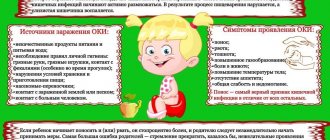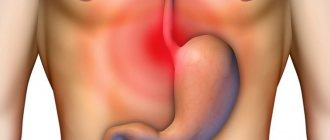Children quite often suffer from gastroenteritis, since inflammation of the mucous membrane of the digestive organs - the small intestine and stomach - is provoked by causes that do not pose a danger to adults.
Infectious gastroenteritis in children can develop not only due to the introduction of rotovirus, but also due to diseases of a different etiology, if pathogenic microorganisms have spread through the bloodstream. Symptoms of gastroenteritis can appear when the diet is disrupted, or when a new type of food is introduced into the diet. It is especially dangerous that when pathogenic microorganisms become active in the stomach and intestines of babies, they involve the respiratory organs in the inflammatory process.
Causes and risk factors
The development of gastroenteritis in children can be caused by exposure to infectious and non-infectious agents that irritate the mucous membrane of the digestive tract and disrupt their functions. These include:
- viruses (enteric adenoviruses, caliciviruses, rotaviruses, coronaviruses, astroviruses);
- bacteria (Escherichia coli, salmonella, shigella, campylobacter);
- protozoa (cryptosporodia, dysenteric amoeba, intestinal lamblia);
- helminths (crooked heads);
- food allergens (crabs, strawberries, chicken eggs);
- poisonous mushrooms (false honey mushrooms, fly agaric);
- toxic fish products (mackerel caviar, burbot liver);
- some medications (iodine and bromine preparations, sulfonamides, antibiotics, non-steroidal anti-inflammatory drugs).
Gastroenteritis in children is most often associated with infectious agents
Provoking factors:
- plentiful roughage foods rich in fiber;
- spicy seasonings;
- cold carbonated drinks;
- general hypothermia;
- intestinal dysbiosis;
- hypovitaminosis conditions.
Bacteria, viruses, toxic substances or allergens, once in the gastrointestinal tract, damage the epithelial cells of the mucous membrane, thereby causing an inflammatory process. The biologically active substances formed in this process irritate the nerve endings, which causes abdominal pain, nausea, and vomiting. In addition, inflammation damages the villi of the small intestine. This disrupts the process of digestion, absorption of water, electrolytes and nutrients, leading to an increase in osmotic pressure in the lumen of the small intestine. The result is diarrhea (frequent loose stools).
The occurrence of gastroenteritis in children can be associated with the action of various factors, but in pediatric practice, the most common infectious form of the disease is observed, which is most typical for children of early and preschool age.
Viruses and bacteria in the process of vital activity synthesize toxins that are absorbed into the bloodstream and spread throughout the body, causing signs of general intoxication (fever, headache, lack of appetite), characteristic of acute gastroenteritis in children of infectious origin.
Predisposing factors
- insufficient adherence to personal hygiene rules. The child has not developed the habit of washing his hands after visiting the toilet, after walking, and before eating;
- early age. Children under one year of age have functional immaturity of the digestive system. The production of IgA, which plays a major role in the development of local immunity, is not fully produced in infants;
- insufficient heat treatment of meat, fish, eggs during their preparation;
- poor processing of fresh vegetables and fruits before eating them;
- contact with patients with acute intestinal infection (children with vomiting, loose stools, fever);
- poor hygiene practices among adults providing direct care for a young child. It is important that parents wash their hands after changing their baby's diaper. A nursing woman should perform breast hygiene every time before feeding. With artificial feeding, great attention should be paid to the cleanliness of nipples and bottles. The toys that the child plays with must also undergo the necessary, regular treatment.
Forms of the disease
Depending on the duration of the course, gastroenteritis in children is divided into acute and chronic forms. Acute gastroenteritis is characterized by severe clinical symptoms and lasts 7–10 days. The chronic form of the disease is characterized by a cyclical course, in which remissions are replaced by periods of exacerbation.
Depending on the etiological factor, the following forms of acute gastroenteritis in children are distinguished:
- viral – the causative agents are viruses, the transmission mechanism is fecal-oral. Outbreaks of the disease are mainly observed in the cold season. The incubation period is 1–3 days. In this case, symptoms of gastroenteritis in children are often combined with symptoms of ARVI (sore throat, dry cough, runny nose);
- bacterial – caused by pathogenic bacteria. The incubation period is short, usually less than 24 hours. Epidemiological outbreaks are more often recorded in the summer. The disease occurs with pronounced signs of general intoxication and damage to the gastrointestinal tract;
- toxic – provoked by the ingestion of various toxic substances (salts of heavy metals, household chemicals, poisonous mushrooms, alcohol and many others);
- helminthic - associated with parasitism of worms, which in the process of life damage the mucous membrane of the small intestine. Symptoms of gastroenteritis in children with this form are usually blurred, resembling the chronic form of the pathology. The disease is recorded throughout the year;
- allergic (eosinophilic) – develops with increased sensitivity to certain foods that act as allergens. Most often these are eggs, cereals, and dairy products. An allergic reaction is accompanied by the migration of eosinophils into the mucous membrane of the intestines and stomach, which leads to its inflammation, the formation of infiltrates and dysfunction;
- nutritional – provoked by errors in nutrition, consumption of food inappropriate for age. Lasts 1–2 days.
According to the characteristics of the clinical course of acute gastroenteritis in children, three degrees of severity of the disease are distinguished:
- Easy. Body temperature is not elevated, there is no vomiting or only once, diarrhea no more than 3-5 times a day, there are no signs of dehydration.
- Average. Body temperature rises to 38-39 °C, the child complains of pain in the abdominal area. Repeated vomiting occurs, and the frequency of bowel movements can reach 10 times per day. The loss of electrolytes and water through feces and vomit leads to the development of a mild degree of dehydration, which is manifested by a loss of up to 3% of body weight, tachycardia, decreased diuresis, dry mouth and an increased feeling of thirst.
- Heavy. Body temperature reaches 40-41 °C, repeated vomiting mixed with bile, stool frequency 15-20 times per day. Severe dehydration develops - body weight loss exceeds 4%, dry mucous membranes and skin, disturbances of consciousness, cyanosis, a significant decrease in the number of urinations and the amount of urine discharge, and convulsions are noted.
In most cases, acute gastroenteritis in children ends with recovery within 7–10 days.
Possible complications
Every year, more than 1 million people die from the consequences of severe pathology around the world. The main danger is critical dehydration, when metabolism in the body is disrupted.
Dehydration is a pathological dangerous condition caused by a lack of fluid.
Severe dehydration contributes to:
- irreversible changes in the kidneys;
- blood thickening, dysfunction of the heart, blood vessels, slow heartbeat;
- disruption of the supply of nutrition to the brain.
All of the above conditions can cause death in the absence of timely assistance.
Cerebral edema is a pathology associated with an increase in the size of the brain matter and its compression in the skull. It occurs precisely under the influence of dehydration and progressive intoxication. The functioning of sodium-potassium metabolism is disrupted, so the permeability function of brain cell membranes is lost, fluid accumulates in them, and swelling occurs.
Symptoms of swelling include:
- headache;
- bouts of vomiting;
- vision problems, loss of orientation in space;
- shallow uneven breathing;
- muscle cramps.
Bleeding in the gastrointestinal tract develops with deep trauma to the mucous membrane of the digestive system. This is a rare complication due to the fact that the patient already had ulcers and varicose veins of the gastrointestinal tract.
Symptoms of bleeding include:
- blood in the vomit - bright red admixture, dark red clots, vomiting “coffee grounds”;
- melena - black, spotty stools, usually manifested in the case of bleeding from the small intestine;
- pressure drop;
- tachycardia;
- restless state;
- pale skin.
Complications include intestinal perforation and peritonitis. These are end-to-end violations of the intestinal wall when its contents enter the abdominal region.
In this state they develop:
- uniform bloating;
- temperature rise to 39 degrees;
- frequent urge to defecate;
- lack of urination;
- pain during breathing due to contraction of the diaphragm;
- rapid heartbeat.
Toxic shock is one of the dangerous complications associated with poisoning by toxins from bacteria or viruses.
Shock is manifested by the following symptoms:
- fever, temperature more than 39 degrees;
- drop in blood pressure;
- change in consciousness;
- redness of the mucous membranes of the eyes, mouth, and reproductive organs;
- damage to the liver, kidneys, gastrointestinal tract, central nervous system (central nervous system);
- high risks of coma.
Symptoms of gastroenteritis in children
The clinical picture of chronic and acute gastroenteritis in children varies significantly depending on the form. Acute gastroenteritis occurs suddenly and develops rapidly. Its main symptoms are nausea, vomiting, abdominal pain and diarrhea. If the disease is caused by infectious agents, the child’s body temperature rises, headache appears, and appetite decreases.
Acute gastroenteritis develops rapidly, with nausea, vomiting, severe abdominal pain, diarrhea
With vomit and feces, loss of water and electrolytes occurs, which leads to dehydration of the body. The child experiences extreme thirst, the amount of urine decreases, and its color becomes rich and dark.
Exacerbations of chronic gastroenteritis in children are provoked by errors in diet, stress, and ARVI. Most often they occur in spring and autumn. During an exacerbation, the child experiences abdominal pain, nausea, flatulence, rumbling, polyfecal matter (an abnormally large amount of feces) or diarrhea.
With a long course of the inflammatory process, gradual damage to the villi of the small intestine occurs. As a result, nutrient absorption deteriorates and a number of common symptoms develop:
- weight loss;
- trophic changes in skin, hair, nails;
- weakness;
- increased fatigue;
- irritability;
- sleep disorders.
With chronic gastroenteritis in children, general symptoms persist even during the remission phase of the disease.
Prevention
A nursing mother must constantly monitor the cleanliness of her hands and breasts, since poor hygiene can lead to infection of the baby. If your baby is fed formula milk, you need to control the shelf life and follow all preparation rules. It is also necessary to clean bottles and nipples before feeding.
Infection with coronavirus gastroenteritis occurs by airborne droplets, while rotavirus infection occurs through the fecal-oral route. Therefore, hygiene skills should be instilled in children from a very early age.
You need to prepare food for small children only from fresh, high-quality products. All rules for storing and preparing food must be followed.
Diagnostics
Diagnosis of acute gastroenteritis in children is carried out on the basis of the characteristic clinical picture of the disease and the results of laboratory tests:
- general blood analysis;
- hematocrit;
- serological studies;
- coprogram;
- general urine analysis;
- bacteriological examination of stool with antibiogram.
Gastroenteritis in children can be either an independent disease or a syndrome that develops against the background of acute infectious intestinal infections (salmonellosis, cholera).
If chronic gastroenteritis is suspected, not only laboratory but also instrumental diagnostic methods are used:
- FEGDS;
- Ultrasound of the abdominal organs;
- intragastric pH-metry.
Abdominal ultrasound helps confirm the diagnosis of gastroenteritis in children
Causes of the disease
The occurrence of this disease in children can be caused by pathogenic microorganisms.
- viruses (adenovirus, rotavirus);
- bacteria (Shigella, Proteus, Salmonella, Escherichia coli);
- protists (eg Giardia);
- helminths.
In half of the cases, gastroenteritis in children occurs due to viral infections - most often due to rotavirus.
In addition, a nutritional form of the disease is possible, which occurs when fruits or vegetables are taken together with fermented milk products. Also, an allergy to any food product can contribute to the occurrence of gastroenteritis of varying severity.
This form of the disease does not pose a danger to the child. To cure it, it is necessary to adjust the diet and quality of nutrition.
Treatment of gastroenteritis in children
Treatment of acute gastroenteritis in children begins with a water-tea break for 8–12 hours. At this time, the child is not fed; he is often given warm liquid to drink (unsweetened tea, Regidron or Peditral solution, still mineral water) 1-2 sips every 5-10 minutes. If indicated, perform gastric lavage and give a cleansing enema. After the end of the water-tea break, the child is prescribed therapeutic nutrition (diet No. 4 according to Pevzner), the main purpose of which is mechanical, thermal and chemical sparing of the digestive system.
In severe cases of gastroenteritis in children, treatment is carried out in a hospital, since in this case dehydration quickly develops and there may be a need for intravenous infusion of electrolyte and glucose solutions.
For gastroenteritis in children, diet No. 4 according to Pevzner is prescribed
For bacterial gastroenteritis, antibiotics are prescribed.
In case of a disease of allergic etiology, it is necessary to exclude the product that is an allergen from the diet. This is usually enough to quickly improve the child's condition.
For chronic gastroenteritis, you must follow a diet. Drug treatment is carried out taking into account the etiology. So, if a child has increased stomach acidity, proton pump inhibitors and antacids are prescribed, and if inflammation of the mucous membrane of the stomach and intestines is caused by infection, antibacterial therapy is indicated.
Treatment with folk remedies
Children are a special category, so there are certain restrictions that should be adhered to. If such signs appear in babies under one year old, you cannot self-medicate; in such a situation, you need to call an ambulance, especially if the baby’s condition is rapidly deteriorating. It is easier with older children; they can be given first aid at home. It is as follows:
- It is necessary to normalize the water-salt balance of the body. To do this, you need to drink a solution of Regidron, Citroglucosan, Pedialyte or other similar drugs approved for childhood in small sips every 5 minutes. They contain the required amount of salts and glucose, which are intensively absorbed by the intestinal mucosa and normalize mineral and fluid reserves.
- Also, during home treatment, it is recommended to take sorbents to remove pathogenic microflora from the body. Enterosgel, Enterol, Smecta, etc. will cope with this task.
- If diarrhea and vomiting are pronounced, you can use drugs that stop these processes (Imodium, Enterobene, Hilak Forte, etc.).
Important! If no improvement is observed within 2 days despite treatment, you should consult a doctor. This situation indicates the presence of a viral or bacterial infection and further therapy with antibacterial and other fairly serious drugs is necessary.
- During this period, it is extremely important to follow a diet. During the period of acute manifestations, it is not recommended to give food. Some sources indicate that during treatment it is necessary to refuse food for a day, with the exception of infants. In the future (the next day), you should not give foods that improve intestinal motility (raw fruits, vegetables, dairy products). Simple foods should be gradually introduced into the diet in small quantities; first, you should give crackers, biscuits, low-fat chicken broth and boiled chicken meat, namely breast. It is imperative to drink a lot of fluid, at least half a liter more than the established norm.











